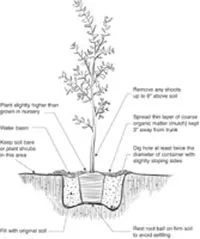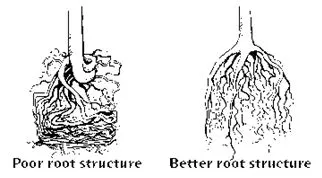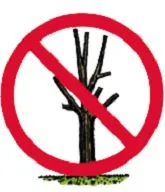Tips for Growing and Maintaining Healthy Trees
1. Select Quality Trees
Nursery tree selection is one of the most important investment decisions a homeowner can make. Healthy trees make our environment more pleasant and increase the value of our real estate. A large shade tree can also provide relief from the summer's heat and reduce summer cooling costs. To make a successful tree selection, choose the "right tree for the right space". High quality trees have certain characteristics that are worth knowing when you head to the nursery to purchase your tree.
Printable Quick Tip
Quality Nursery Tree Selection
Additional Information
High Quality Nursery Tree Selection Specifications

3. Proper Staking
Some young trees need support during their first years of growth, and this is supplied by staking the tree. How a tree is staked affects the tree trunk's strength and shape. Improper staking can do more harm than good. A badly staked tree may be injured by the stakes or ties and fail to develop a strong, straight trunk. See trees and turf section below.
Printable Quick Tip
Tree Staking
5. Pruning Mature Trees
Landscape trees that are carefully selected and properly planted, trained and maintained should require little pruning after they reach maturity. Such trees require only the removal of poorly positioned or stongly competing limbs, weak branch attachments, or branches that are damaged or dead. Mature trees should be inspected annually to assess overall structure and to determine if any limbs should be removed. Trees with dense foliage may benefit from some crown thinning to improve light penetration and air movement. Improper pruning can lead to various future problems, increased cost and hazards. As well-pruned tree, best done by a certified arborist , should look as if it has not been pruned.
Printable Quick Tips
Pruning - Thin, Don't Top
Tree Pest and Diseases
Additional Information
Pruning Landscape Trees
Hiring A Tree Service
Don't Top Trees
Center for Urban Forest Research

2. Proper Planting
A healthy tree begins with correct planting procedures. To avoid poor growth or death of a young tree, it is wise to invest some time to learn the right way to plant a tree. Proper planting techniques are not difficult to master, and a well-planted tree will grow and prosper more rapidly. Newly planted trees are more likely to survive and prosper if mulched. Landscape trees which are planted in or near lawns require special treatment.
Printable Quick Tip
avocado tree
Additional Information
Planting Landscape Trees
Planting a Tree - A Step by Step Guide
4. Training Young Trees
Training and caring for young trees is, in some ways, a lot like raising children. Give them care and attention, a little discipline and consistent structure in the early years and there will be fewer problems later on. Trained trees are structurally stronger, less likely to break apart in a storm, and require less maintenance. Well trained trees will not have to be removed because they are too large for the space, drop leaves into the neighbor's pool, or their unbalanced limbs pose a hazard.
Printable Quick Tip
Training Young Trees
Additional Information from the Urban Tree Foundation
Training Young Trees


